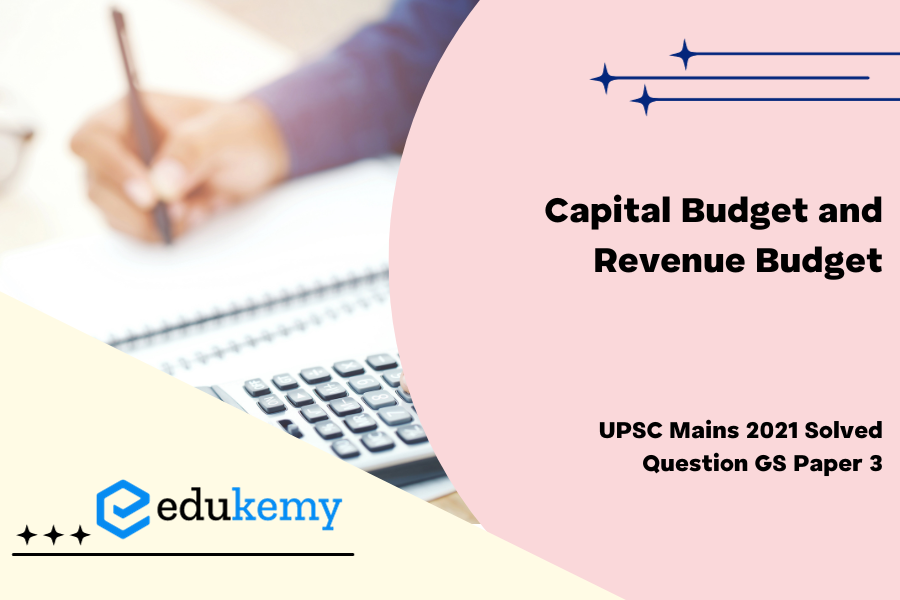Capital Budget focuses on long-term investments like infrastructure and assets, while revenue Budget pertains to day-to-day operational expenses. Capital Budget includes capital expenditure and loans, while Revenue Budget comprises revenue receipts and revenue expenditure like salaries and maintenance costs. Distinct management is crucial for fiscal health.
UPSC Mains General Studies Paper – 3 Mains 2021
UPSC Mains Civil Services IAS Exam Question Paper – 2021
Contents
Approach
- Start with a brief introduction of the budget and its constitutional provisions.
- Discuss the Distinguish between Capital Budget and Revenue Budget.
- Explain the components of both the Capital Budget and Revenue Budget.
- Conclusion accordingly.
Answer
Introduction
- Article 112 of the Indian Constitution, the Annual Financial Statement (AFS) is the term used to denote the Union Budget for a given year. The AFS presents an overview of the Government’s anticipated income and expenses during a financial year, commencing on 01 April of the present year and concluding on 31 March of the subsequent year. The Objectives of Budget Reallocation of resources, Reducing inequalities in income and wealth, Contributing to economic growth, Bringing economic stability, Managing public enterprises .
Body
The Distinguish between Capital Budget and Revenue Budget: The capital budget and revenue budget are two distinct components of the Union Budget. Here’s key points :-
Capital Budget
- Deals with capital expenditure and investments made by the government.
- Focuses on long-term infrastructure development and asset creation.
- Includes expenditure on acquiring or creating assets like buildings, roads, bridges, machinery, etc.
- Aims to enhance the productive capacity of the economy and improve public services.
- Examples: Construction of highways, airports, dams, investment in education and healthcare infrastructure.
Revenue Budget
- Deals with day-to-day operational expenses and recurring income of the government.
- Includes revenue receipts and revenue expenditure.
- Revenue receipts consist of tax revenues, non-tax revenues, grants, and interest earned.
- Revenue expenditure includes salaries, subsidies, pensions, maintenance costs, etc.
- Examples: Salaries of government employees, subsidies on essential commodities, welfare schemes, healthcare expenses.
The components of both the Capital Budget and Revenue Budget: the components of both the Capital Budget and Revenue Budget:
1. Capital Budget
- Capital Receipts: These are the receipts that lead to a decrease in assets or an increase in liabilities of the government. In India, capital receipts mainly include:
- Disinvestment proceeds: Money earned by selling assets like shares of public enterprises.
- Borrowings and loans: Funds received through borrowings or repayment of loans by the government or states.
- Capital Expenditure: This refers to the expenditure incurred by the government that leads to the creation of assets or reduces liabilities. The components of capital expenditure in India include:
- Investments in infrastructure: Long-term investments made by the government to create assets such as building roads, bridges, hospitals, schools, etc.
- Loans to states: Funds provided by the central government to the states or repayment of its own borrowings.
2. Revenue Budget:
- Revenue Receipts: These are the receipts that do not directly impact the assets or liabilities of the government. In India, revenue receipts primarily consist of:
- Tax revenues: Money earned through various taxes imposed by the government, such as excise duty, income tax, GST, customs duty, etc.
- Non-tax revenues: Income generated through sources like dividends from public sector undertakings, interest receipts, profits from government enterprises, fees, fines, etc.
- Revenue Expenditure: This refers to the day-to-day operational expenses incurred by the government. The components of revenue expenditure in India include:
- Salaries and pensions: Payments made to government employees, including salaries, allowances, and pensions.
- Interest payments: Payments of interest on loans and debts.
- Subsidies: Financial support provided by the government to individuals or sectors to promote economic activities or alleviate hardships.
- Administrative expenses: Costs associated with running the government machinery, such as maintenance, office expenses, and other administrative costs
Conclusion
- Hence, While the Capital Budget contributes to long-term economic growth and development, the Revenue Budget ensures the smooth functioning of government operations and public service delivery. Both budgets play critical roles in managing financial resources, balancing expenditures, and addressing the diverse needs of the country.
In case you still have your doubts, contact us on 9811333901.
For UPSC Prelims Resources, Click here
For Daily Updates and Study Material:
Join our Telegram Channel – Edukemy for IAS
- 1. Learn through Videos – here
- 2. Be Exam Ready by Practicing Daily MCQs – here
- 3. Daily Newsletter – Get all your Current Affairs Covered – here
- 4. Mains Answer Writing Practice – here


